Linoleum is a relatively inexpensive type flooring, which can be made from both synthetic and natural materials. Modern manufacturers offer a large selection of coatings that differ not only in technical specifications and texture, but also color scheme. We will tell you which linoleum colors are the most popular today, how to choose the right shade and which interior items are best combined with them.
Why is it so important to consider the color of linoleum?
One of the most important roles when decorating a room is played by color. It can influence the mood by creating a certain atmosphere in the room. Bright and varied colors of linoleum allow you to decorate the room in almost any style, from country to modern.
Thanks to the wide range of colors of PVC coatings, you can decorate almost any space, making it visually more voluminous or, conversely, cozy. However, one should also take into account the fact that very saturated tones excite the nervous system, so when arranging the bedroom and lounge rooms they should be used with caution.
The most popular coating colors

Despite the emergence of many synthetic floor coverings providing alternative natural materials, at the peak of popularity, as before, are the colors inherent in various types of wood: oak, beech, cherry, ash, pine and wenge. In this regard, we can distinguish three “leaders” from the entire variety of colors:
- Brown. Great for creating an interior in country or Provence style. Warm shades of brown make the atmosphere in the room more homely and cozy. In addition, they have a calming effect on the nervous system, so they are recommended for use in decorating bedrooms and living rooms;
- Walnut. The warm shade of linoleum will not disturb the idyll classic style. This floor can be combined with light furniture and fairly bright interior accessories: paintings, panels, vases, etc.;
- Bleached oak.
But before choosing the color of linoleum, you need to decide on the pattern, the size and geometry of which can visually expand or reduce the space. If you need to visually enlarge the room, give preference to linoleum with small ornaments.
Rules for choosing colors
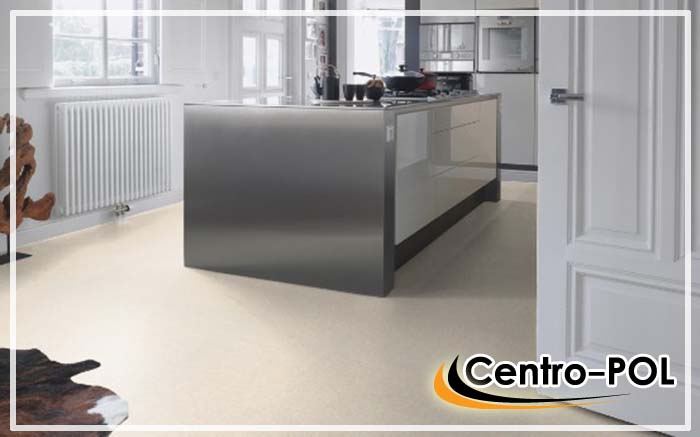
How to choose the color of linoleum? In order not to make a mistake with the color and shade of the floor covering, it is worth considering several important rules:
- It is advisable to use blue and light blue linoleum in rooms located on the sunny side. They will make the interior more fresh and restrained;
- Dark linoleum. It will create a depressing environment, which will make it uncomfortable to be in the room;
- <Желтый и красный пол не испортит просторную комнату, в которой стены и потолок будут окрашены в более спокойные пастельные тона;
- Light linoleum is a “sentence” for compact spaces. It will visually expand the boundaries of the room, thereby creating a calmer and more comfortable atmosphere in it;
- Pink and green linoleum in calm shades can decorate a child's room. An unusual and at the same time “calming” color scheme is best combined with light walls and ceilings;
- For the bedroom and living room, it is best to choose flooring whose texture and color will imitate natural wood, unless, of course, we are talking about an industrial style, as well as high-tech and modern.
How does the color of linoleum affect the psyche?
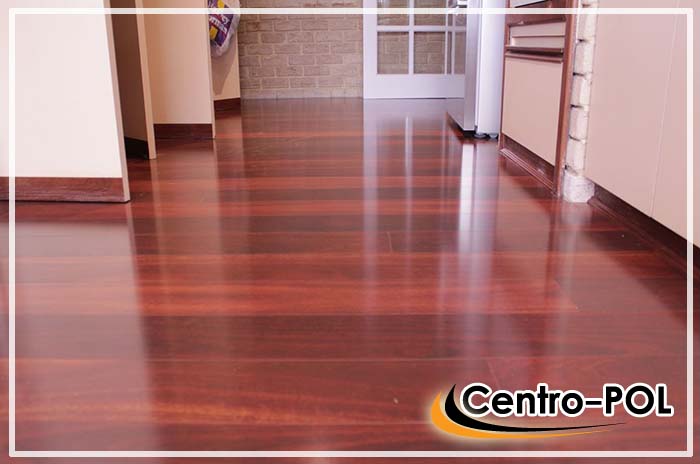
Many interior designers insist on careful selection of coating colors. This is due not only to the compatibility of the coating with furniture, decoration and interior items. The fact is that colored gender can influence a person’s mental state in a certain way:
- “Poisonous” flooring tones make the space more “dynamic”, so they should never be overused, especially when it comes to compact rooms. If you choose, for example, a bright red floor, ceiling, and walls, it is advisable to do it in a calmer color scheme;
- Monochrome black linoleum will emphasize the severity of the classical, English and Egyptian style, in which a riot of colors would be simply inappropriate. It has a calming effect on the psyche, in contrast to very bright and catchy colors;
- Soft pastel colors such as beige or ivory promote relaxation, so they allow you to create unobtrusive but “optimistic” styles such as Renaissance, French or Japanese.
Common Mistakes

The combination of colors in the interior is a very delicate matter, especially when the combination is not done by a professional. To avoid being disappointed with the final result, pay attention to the following common design mistakes:
- Overload with one color. Of course, the floor should be in harmony with some elements in the room: furniture, wall or ceiling decoration, but not with everything at once. For example, it is not advisable to combine gray linoleum with a light ceiling and “faceless” furniture. This will create an uncomfortable and lifeless atmosphere in the room;
- Linoleum and furniture are the same color. Floor furniture should not be the same shade as the floor. In such a case, it seems that the furniture and flooring are one whole;
- Abuse of bright colors. Very bright linoleum, especially red and orange, does not harmonize with flashy wall decoration and large interior items;
- Monochrome in everything. Black and white linoleum in combination with a black and white ceiling and walls will most likely give the impression that you are not in a room, but on a chessboard. Such an extravagant decision will begin to depress over time.
How to correctly combine colors in the interior?
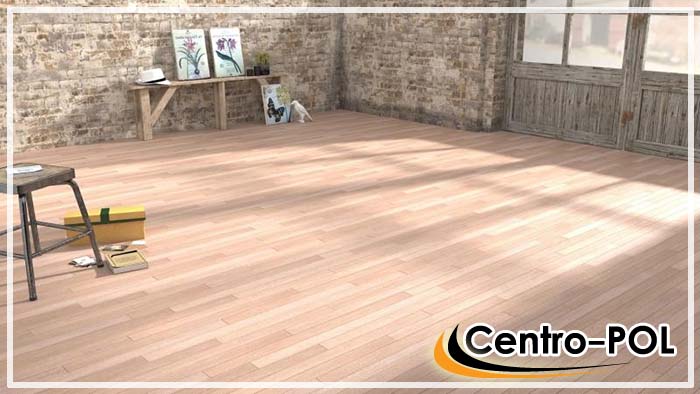
To create harmony and comfort in a room, you need to know a few simple but very important rules for combining different shades. Knowing these features, you will be able to visually expand the limits of compact spaces, making them brighter and more comfortable:
- The effect of increasing space. White linoleum in combination with light walls and ceiling will significantly expand the boundaries of the room, making it more spacious;
- The effect of lengthening the room. To make the room longer, it is advisable to choose light, modern linoleum and paint the back wall of the room in any shade of beige. In this case, it is advisable to make the walls and ceiling dark;
- The effect of reducing the depth of space. Suitable for “leveling” recessed rectangular rooms. All surfaces in the room are made light, except for the back wall, which should be painted in a darker color;
- The effect of reducing the height of a room. It is quite difficult to create a cozy atmosphere in rooms with high ceilings. But if you paint the walls beige, and the ceiling and floor brown or dark gray, the room will become much more comfortable.
Which manufacturers should you choose?
When choosing a coating, it is important to take into account not only its shade, texture and technical characteristics indicated on the packaging, but also the manufacturer’s company. This is the only way to be sure of a long service life of the floor, as well as the absence of harmful impurities in its composition. So, the top 3 best linoleum manufacturers are as follows.
Which linoleum is better to choose for your home? How to correctly decide not only on its color, but also on its type? Anyone who has chosen this convenient, high-quality and inexpensive material as a floor covering has probably asked themselves similar questions.
Linoleum comes in a variety of varieties; it can be natural and synthetic, thin and warm with a felt layer, household and commercial. And the colors and textures of the surface generally amaze with their diversity.
Why choose linoleum?
Floor covering - linoleum
Linoleum coating has a number of advantages, including:
- Durability and strength of the coating;
- Easy to install. You can lay such a covering with your own hands, without involving specialists. For such work you do not need to have skills or expensive tools. Before laying, the surface is prepared very quickly and simply;
- Variety of material. Linoleum is available in numerous types: from natural versions to synthetic ones, from thin to thick coverings with a warm felt layer. There are special moisture-resistant ones for bathrooms, durable ones for high-traffic areas, with a protective layer and many others;
- Relatively low cost of coverage.
Which is better for hallways and which for the kitchen?
Linoleum is available in several types:
- Homogeneous. This is a homogeneous thin canvas with a thickness of one and a half to three millimeters. The design is usually the simplest, but it is made through and does not wear out. It is preferable to lay such material in places where heavy loads are expected - in corridors, hallways, on balconies;
- Heterogeneous. Multilayer linoleum, characterized by high density and high quality. The thickness of this type can range from two to six millimeters.
Ideal for kitchen, toilet. It usually consists of:
- Back layer;
- There is a layer of foamed PVC;
- Reinforcing fiberglass;
- PVC layer with pattern;
- Decorative surface;
- A protective transparent layer - this can be a special varnish coating with antibacterial additives;
- Mixed. This linoleum consists of: a homogeneous coating, a layer of PVC, non-woven fiberglass, and a protective polyurethane film. Perfect for a bedroom or living room.
Classification: what to use and what to refuse?
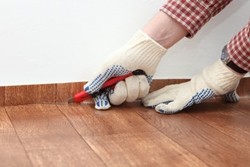
Laying linoleum
So how to choose the color of linoleum and its type correctly? Depending on the purpose of the room and the expected loads, all linoleum produced can be divided into four groups:
- Domestic;
- Commercial option;
- Semi-commercial;
- Special.
For a household coating, the characteristics are as follows: very thin, strength – medium, deformation – up to 0.2 millimeters, withstands load – from 1.25 to 2.25 kg/m2, cracks do not appear when twisted, has good sound insulation. The width of such linoleum is approximately from one and a half to four meters.
Usually used in living spaces, bedrooms, hallways. It is not recommended to lay it in bathrooms, kitchens, or balconies, as it does not tolerate high humidity and significant mechanical loads very well. The question of how to choose the color of this type of linoleum is easily resolved - it’s a matter of taste. Many products are produced in various shades and patterns, with wood textures, with floral patterns, and with simple geometric patterns.
Commercial linoleum is a coating of increased strength and wear resistance. It has great thickness, density, and a protective layer. The service life is up to 25 years. Its use for residential premises is limited only by its rather high cost, in comparison with household and semi-commercial ones.
The characteristics of commercial linoleum are as follows: withstands loads of up to three kgm.sq., deformation - up to 0.1 millimeters, cracks do not appear when twisted (10-10 millimeters), has a protective layer with a thickness of up to 0.8 millimeters, perfectly absorbs noise, width canvases from 2 to 5m. The color range is plain shades, imitation stone, ceramic tiles, wooden surfaces. The color is usually muted, not bright.
Semi-commercial linoleum combines the strength of commercial and the relatively low cost of household. This is a thinner coating, its strength is much higher than the strength of household linoleum. It has a layer of protection against abrasion, damage, and mechanical stress. Characteristics: loads - from one and a half to two kg/m2, protective layer - 0.5-0.6 millimeters, absorbs noise well, no cracks when twisting (with a diameter of 10-40 millimeters).
Special types of linoleum are determined depending on the requirements. These could be things like:
- Antistatic agents. These are special conductive and current-dissipating coatings, which are usually laid in rooms with a high content of static electricity. They are practically not used for residential premises;
- Anti-slip linoleum. Quartz or carbundum chips are added to this coating. I use it for bathrooms, kitchens, and on balconies. This coating prevents slipping when there is a large amount of liquid;
- Acoustic models. The thick foam backing perfectly absorbs noise. This linoleum has shock-absorbing properties and is very soft. Mainly used for children's and living rooms.
Choosing linoleum by color
Now you can decide what the color of the linoleum will be. The color scheme of this coating is divided into warm and cold, while warm shades will give unique comfort and tranquility, while cold shades can visually enlarge even a small room.
When choosing, you must first of all be guided by the purpose of the room and its characteristics. So, warm colors are perfect for bedrooms and living rooms: sand-brown, beige, cream, golden shades; for children’s rooms, brighter and richer colors are needed; bathrooms and kitchens will look great if you use blue, green, light green, sandy shades.
The color of linoleum and the pattern should not only be suitable for its intended purpose, but also be in harmony with the rest of the design of the premises. For corridors, hallways - this can be an imitation of natural stone and ceramic tiles of any color; bathrooms allow the use of cold and bright colors; for the kitchen, this can be an imitation of tiles, stone, or a wooden surface.
In bedrooms, it is better for the color of linoleum to be calm and monochromatic, but in children's rooms and areas for relaxing and receiving guests, a variety of colors can be used.
When choosing a color scheme, you should follow these simple recommendations:
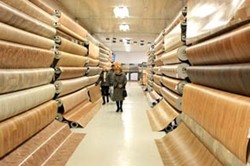
When choosing, it is advisable to give preference to the following options:
- The color of the floor should be a couple of tones lighter than the tone of the furniture;
- Floral patterns and imitation wood coverings will fit perfectly into any design;
- Brown shades with various combinations are universal.
When choosing the color of linoleum is determined by the following factors:
- Contrasting shades and accessories perfectly complement the design and create a feeling of comfort;
- If the walls have a rich color, linoleum should be taken in calmer colors;
- When choosing, you must be guided by the purpose of the room;
- The pattern of the floor covering can give the design different moods: strict diagonal ones visually increase the area and are more suitable for work areas; bright and dynamic - for recreation areas; calm, plain colors - for bedrooms, living rooms.
So how to choose the right color of linoleum for your home? It is still advisable to focus on what the room is intended for and what exactly you want to get in the end. The color of the future coating plays an important role in this:
- Yellow is a warm color that can be used in living rooms, dark kitchens, and in rooms where you do not plan to stay during the day;
- Orange is ideal for the dining room and kitchen;
- Red is an active color, it should be used very carefully, it is not recommended in the kitchen, in the nursery, or for the rooms of the elderly;
- Pink is soft and soothing, but is not suitable for classic interiors;
- Purple - in combination with gold and yellow can be used in bedrooms;
- Blue is the color for recreation areas;
- Blue can visually enlarge a room, recommended for hallways, corridors, living rooms, bathrooms, kitchens;
- Green is an ideal option for flooring and can be used in any room;
- Brown supports comfort and calm;
- Black is rarely used in combination with another color.
When resolving the question of how to choose the color of linoleum, you should be guided by color harmony schemes and your own preferences.
Thanks to the optimal price-quality ratio, linoleum occupies a leading position among the variety of floor coverings. Although there was a period of time when this flooring was considered outdated and inferior to other types of flooring, it has recently begun to regain its popularity.
What are the main points you should pay attention to when choosing linoleum for the kitchen?
Linoleum is an environmentally friendly flooring made from natural materials. This wear-resistant coating has a very long service life. Linoleum is resilient and has antibacterial properties, making it a particularly good choice for kitchens.
Four selection criteria will help you learn better about the features of linoleum:
Material. Linoleum is made from natural materials including linseed oil, resin, wood flour and pigments.
Since these materials are of natural origin, they are also biodegradable, which is considered a definite advantage when choosing an environmentally friendly coating.
In addition, flaxseed oil is a powerful antiseptic. Thanks to this property, linoleum will protect the floor from harmful bacteria throughout its entire service.
Thickness. The kitchen floor has a purpose rather than a decorative purpose. The appropriate kitchen covering must withstand heavy loads without deforming, remain wear-resistant, and maintain an impeccable appearance.
The thickness of linoleum determines its wear resistance. Especially for kitchens there is linoleum with a thickness of 4-5 mm. This high-performance coating will withstand any intense load.
Coating. Unlike vinyl flooring, the pigments in linoleum run throughout the entire thickness of the material. Any scratches or heavy wear will be the same color as the surface, minimizing visual impact.
Slip. An important feature of linoleum is that, due to its coating, it usually has a rough surface. Therefore, linoleum is popular in places with high humidity.
The fact that this flooring is so easy to clean adds a lot of benefits, but the benefits don't end there.
Which is better – parquet or linoleum?
Linoleum, compared to hardwood flooring, is a less expensive way to achieve a more expensive look for a kitchen floor. One of the remarkable advantages of linoleum is that this material can look like wood, stone or any other floor, which cannot be said about parquet.
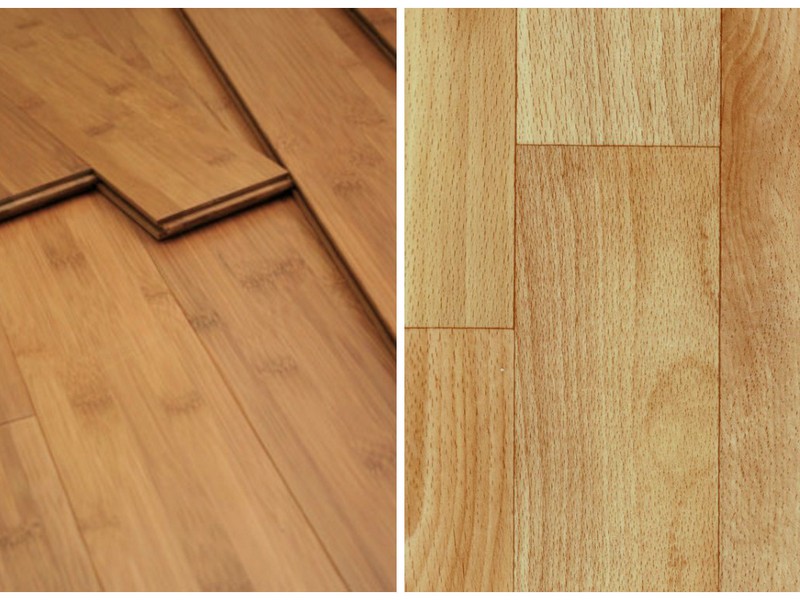
Linoleum has a number of useful qualities:
- Elasticity. Linoleum is an elastic flooring material. This means that soft and elastic linoleum provides a more comfortable experience in the kitchen, especially in places where you will have to stand a lot.
- Strength. The characteristics of linoleum make it a durable material. A well-maintained linoleum floor will save money in the long run, outlasting hardwood flooring.
- Moisture resistance. The surface of linoleum has water-repellent properties, therefore, the formation of mold and fungi is excluded. This makes linoleum a good choice for high-moisture areas such as the kitchen.
- Fire properties. Linoleum is not easily burned or melted by dropping hot or burning objects on it.
- Antistatic properties. Thanks to this property, linoleum is easier to clean, since dust will not stick to the floor surface due to static electricity.
- Unpretentiousness. Small cuts and gouges can be repaired using a spare piece of linoleum.
- Environmental friendliness. As stated earlier, linoleum flooring is gentle on the environment and its components are natural.
- Low cost. Compared to parquet, linoleum is much cheaper.
- Easy installation. Laying parquet flooring will require a lot of time, patience and additional leveling of the floor. Linoleum with a thickness of 3 mm does not require preparatory work or special skills.
And finally, parquet cannot boast of such a wide selection of colors, patterns, ornaments and styles, suitable for various designs, for which linoleum is famous.
Linoleum has many positive qualities, but it also has disadvantages:
- Temporary odor. New linoleum has a pronounced odor due to the content of linseed oil. Over time, the smell will disappear.
- Fading and yellowing. With frequent exposure to direct sunlight, the surface of linoleum quickly fades, and in dark places it turns yellow. This is a temporary discoloration that disappears within a few hours of exposure to sunlight.
Tip: A thin linoleum sheet requires a good, level base, otherwise any defects or imperfections will be “transmitted” through its surface.
What color of linoleum to choose
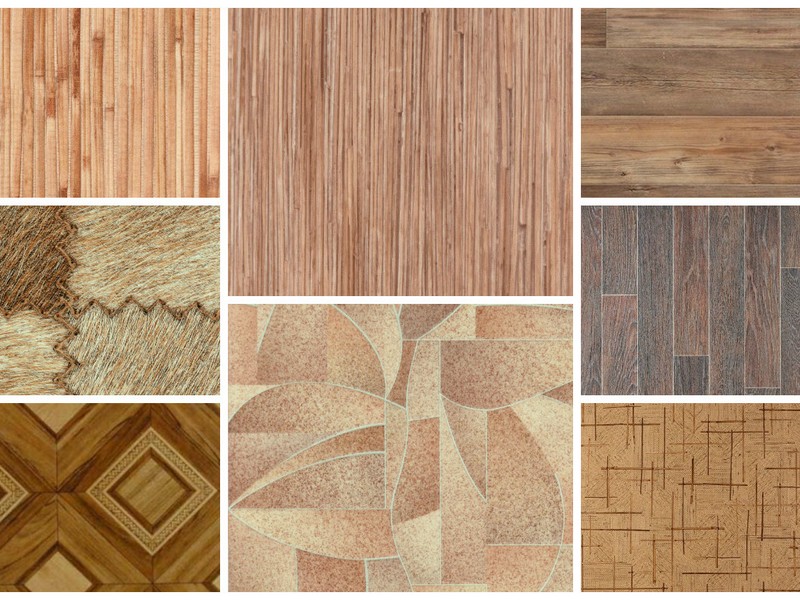
Linoleum is available in a wide variety of colors and patterns. Even if the desired pattern is not available, the cut pieces can be used to create creative floor designs with stripes and patterns to end up with a unique style.
All this variety of colors and structures allows linoleum to imitate other materials. For example, you can make a kitchen floor that looks like wood or marble when it's actually linoleum.
Such a variety of textures allows you to finish the kitchen floor in any style:
- plain material is suitable for high-tech, minimalism, techno or modern style;
- imitation wood will look great in a Provence, vintage, country, eco or any ethnic style interior;
- linoleum with the texture of ceramic tiles will appeal to those who decide to create a retro, classic or avant-garde style;
- geometric and abstract designs are suitable for kitchens in the style of pop art, contemporary or futurism.
This material can accept and maintain very deep, rich colors, providing a wide variety of attractive visual effects.
In some cases, you can purchase linoleum that has intricate patterns and motifs on the surface of the material. However, these intricate designs often require installation experience.
The choice of linoleum color is influenced by the following factors:
- A small kitchen will look more spacious if the covering is made in cool colors, imitates small tiles or wooden flooring laid diagonally.
- The color of the linoleum should match the color of the set.
- For a bright kitchen, you should choose a neutral color covering, and for kitchens with a restrained palette, brightly colored linoleum is suitable.
- You can zone a large kitchen using a well-chosen range of linoleum shades in one color spectrum.
- Warm shades will fill the kitchen with coziness, and a monotonous repeating pattern will have a calming effect.
For a low cost, the buyer gets a chic look with minimal maintenance.
Preparatory work before installation
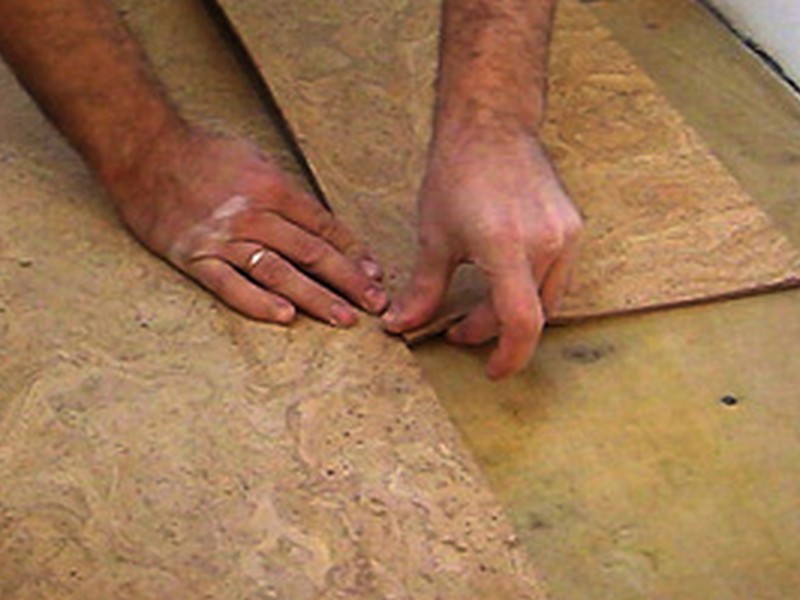 Most suppliers offer to install linoleum sheets, but recognize that buyers can do everything themselves.
Most suppliers offer to install linoleum sheets, but recognize that buyers can do everything themselves.
The surface on which you want to lay linoleum must be smooth, clean, dry, without any impacts, dirt, oil or paint.
To lay linoleum you will need the following tools:
- well-sharpened knives for cutting fabric;
- serrated steel spatula (150-200 mm);
- wooden spatula;
- long ruler;
- double-sided tape, mastic or glue;
- optionally – liquid for welding seams.
Linoleum sheets can be installed over an existing floor as long as it is securely attached to the subfloor. If this is not the case, then you need to get rid of it. If plank flooring is installed in the kitchen, then before installing linoleum, the boards are covered with plywood and screwed with self-tapping screws.
Tip: While working on preparing the floor, you should definitely lay out the linoleum somewhere nearby for a couple of days so that the canvas acclimatizes to room temperature. In an insufficiently warmed state, the linoleum sheet is too fragile.
Laying linoleum
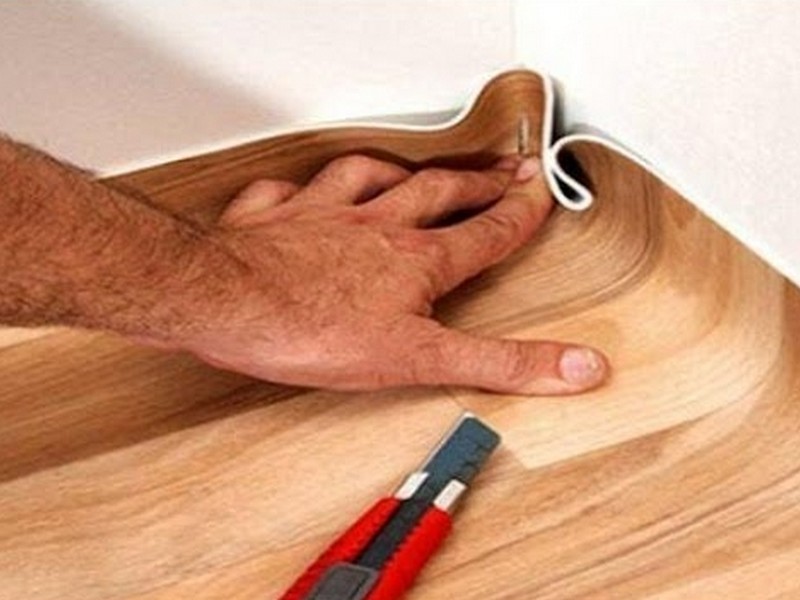 Laying linoleum is easier and faster than preparing to work with it. There are three methods for installing canvases:
Laying linoleum is easier and faster than preparing to work with it. There are three methods for installing canvases:
- No glue required.
- Using glue.
- Pasting with mastic.
The first method is the easiest: Double-sided tape is glued around the perimeter of the sheet and another one at the base. After laying, you need to go over the surface with a wooden spatula to expel the air.
The second method is the most durable: To lay linoleum with glue, you need to bend the sheet to the middle, then apply the glue using a spatula. Before applying the canvas to the floor, you need to hold it in the air, and after laying, squeeze out the air using a smooth spatula. The gluing process is repeated with the second half of the coating.
The third method is too expensive, therefore it is rarely used at home, more often in commercial enterprises.
How much does it cost and where can I buy it?
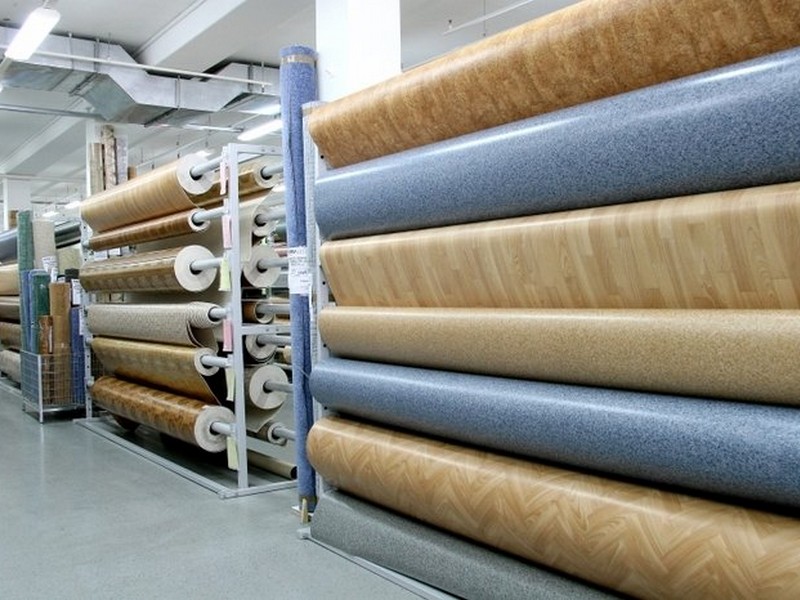 The cost of linoleum depends on several factors:
The cost of linoleum depends on several factors:
- manufacturer country;
- brand name;
- flooring type.
Russian manufacturers offer the simplest linoleum at a cost of 120 rubles per sq. m. m., while the price for foreign goods starts from 300 rubles.
Domestic household linoleum costs from 120 rubles, and foreign from 220 rubles. This type of flooring is designed for light loads. As you know, a low price does not determine the best quality of the material.
Semi-commercial linoleum is much more reliable in quality, which is why it is so valued among buyers. Its price is approximately 300 rubles per sq. m. m.
The next variety is commercial linoleum. A meter of this type of flooring costs from 850 rubles, but it consists of several layers, withstanding a significant load.
Finally, the most expensive material is linoleum made from natural fabrics. The price for this type of flooring is higher than the previous ones - from 1000 rubles.
You can buy linoleum in large construction stores or order from online suppliers.
Top brands
There are several linoleum manufacturers who offer their products through a network of retailers and distributors:
- Forbo (UK);
- ARMSTRONG (UK);
- TARKETT (Germany);
- Sinteros (Russia);
- IVC (Belgium);
- SOMMER (France).
Their products can also be found in several online stores.
When it comes to purchasing high-quality flooring for the kitchen, the deciding factor in this matter, of course, will be durability, environmental friendliness, a large collection of colors and the price of the material. Linoleum fully corresponds to these qualities.
Linoleum for the kitchen, photo
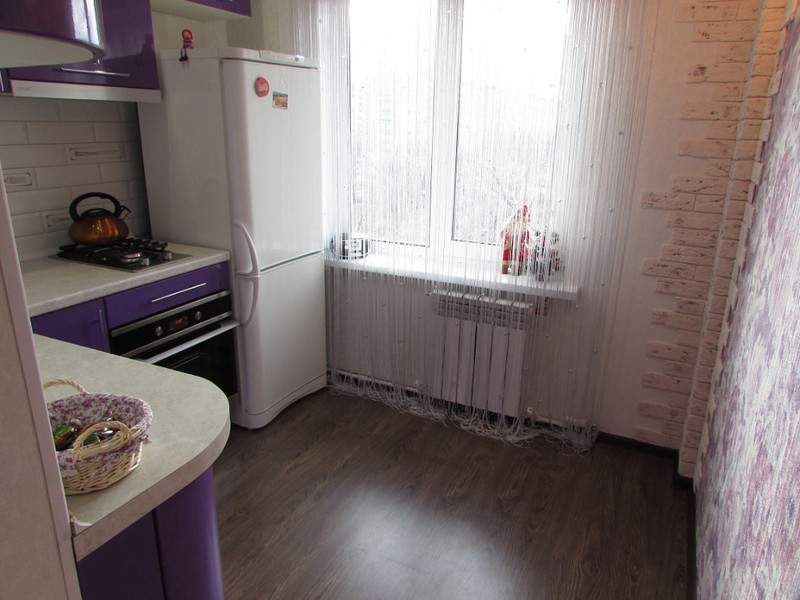
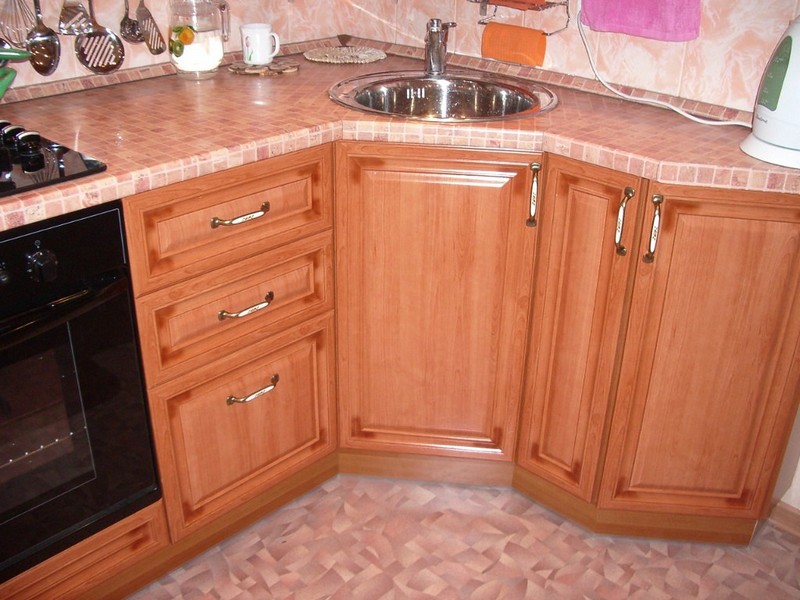
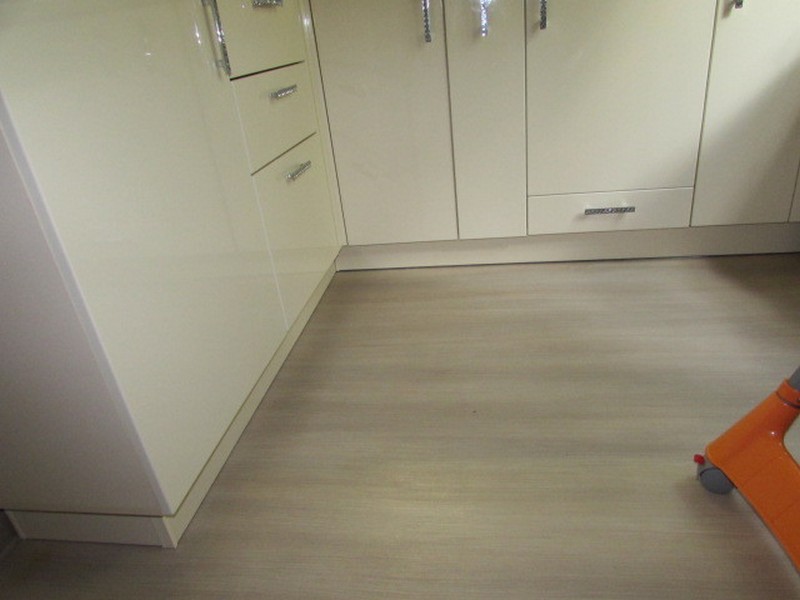
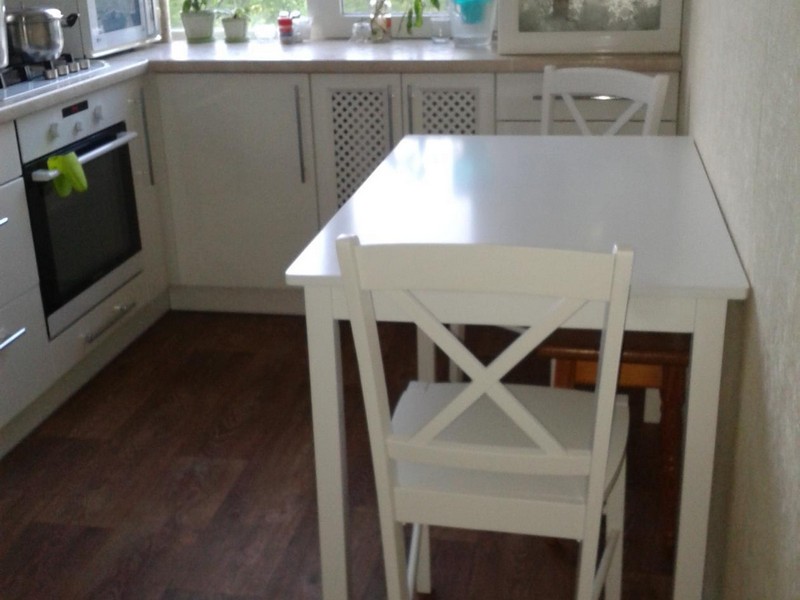


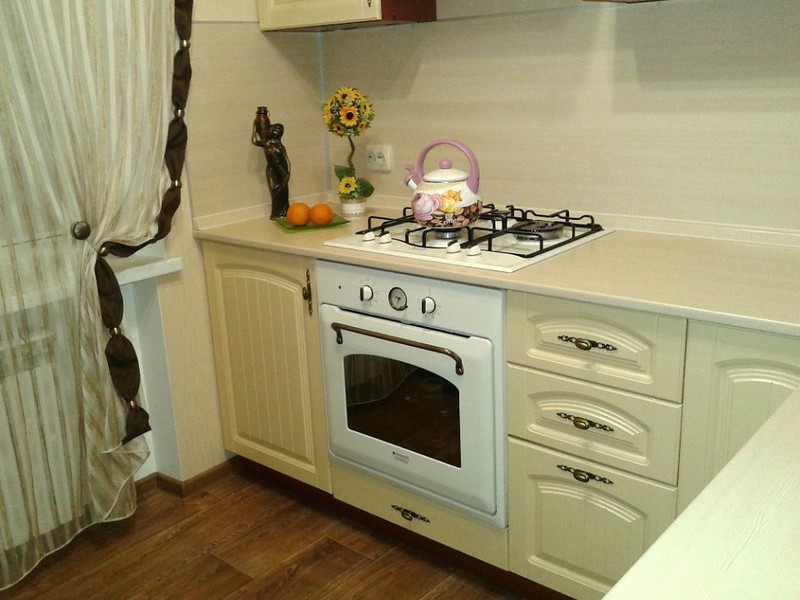
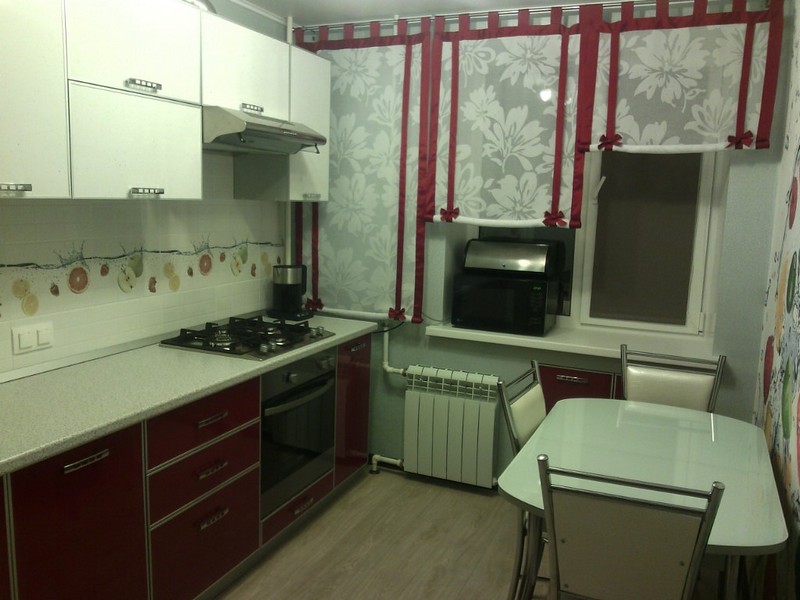

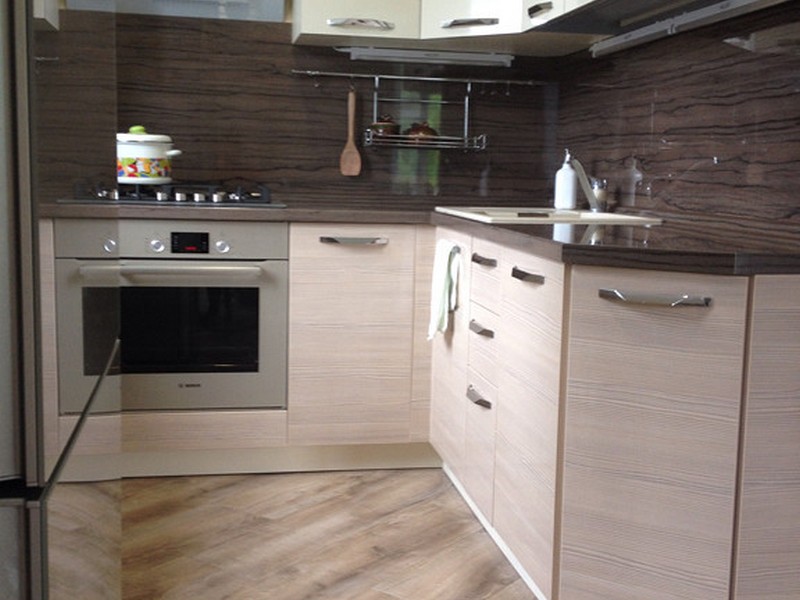
![]()
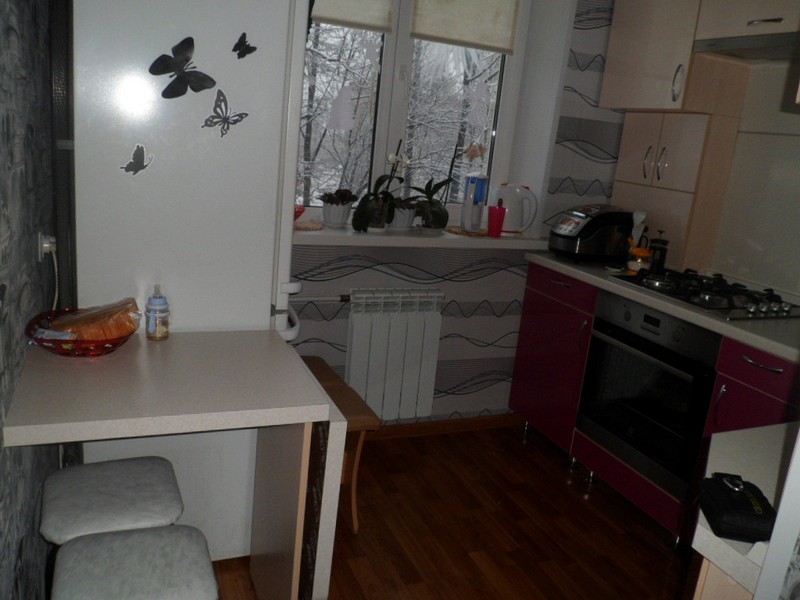
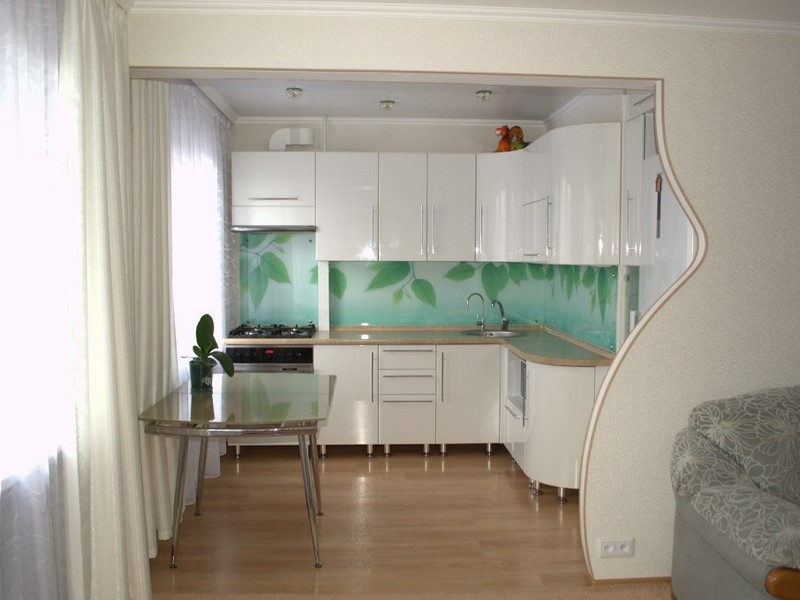

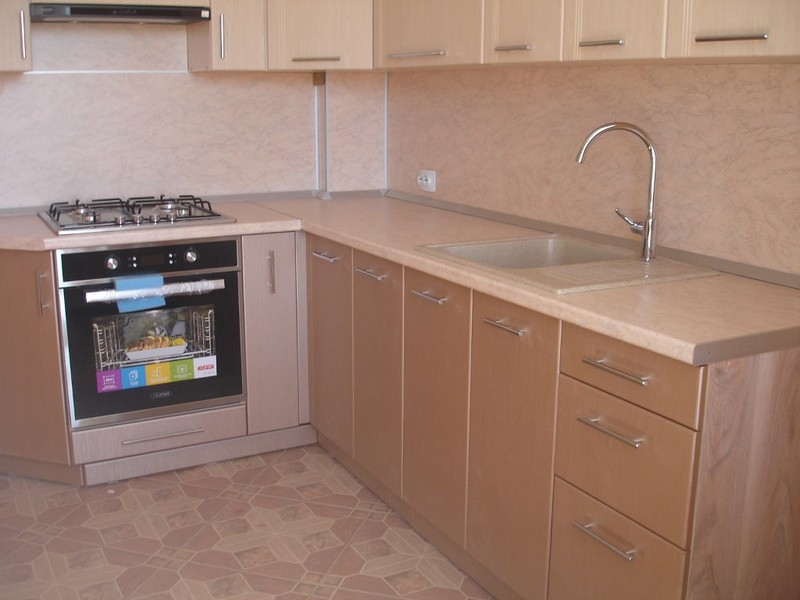
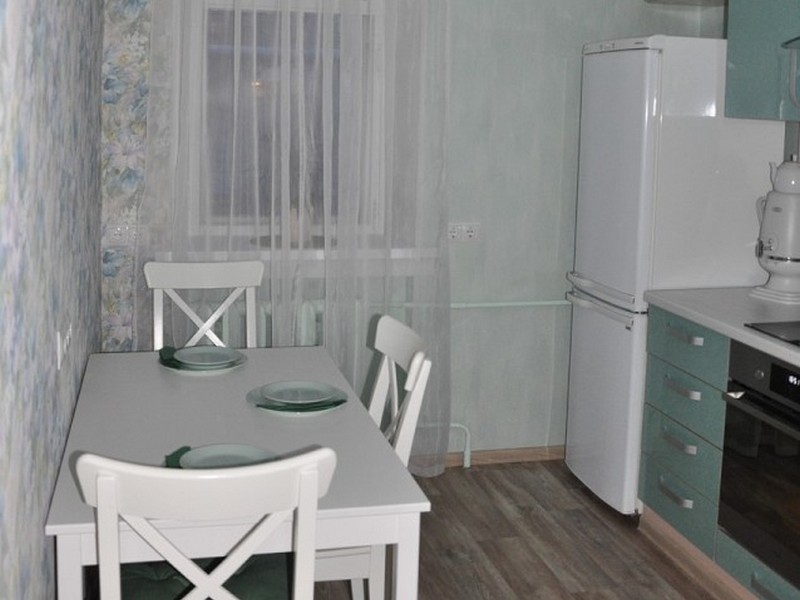

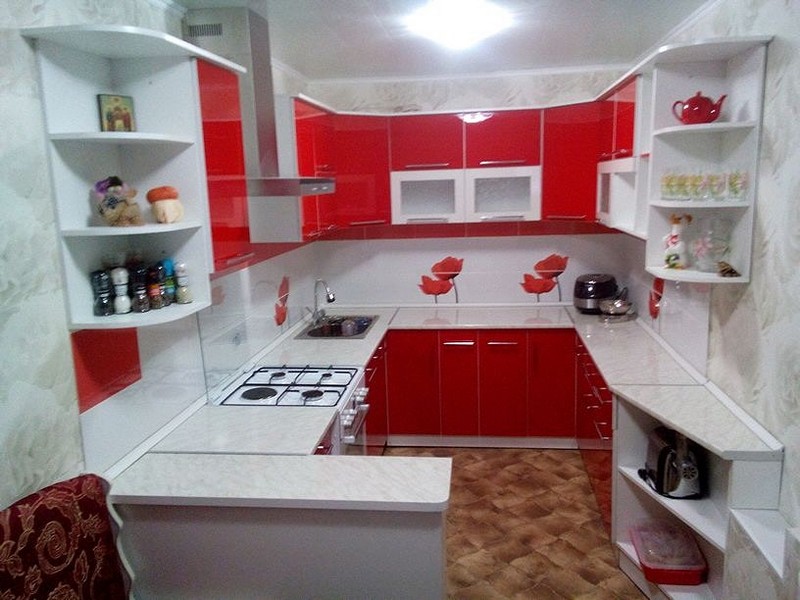
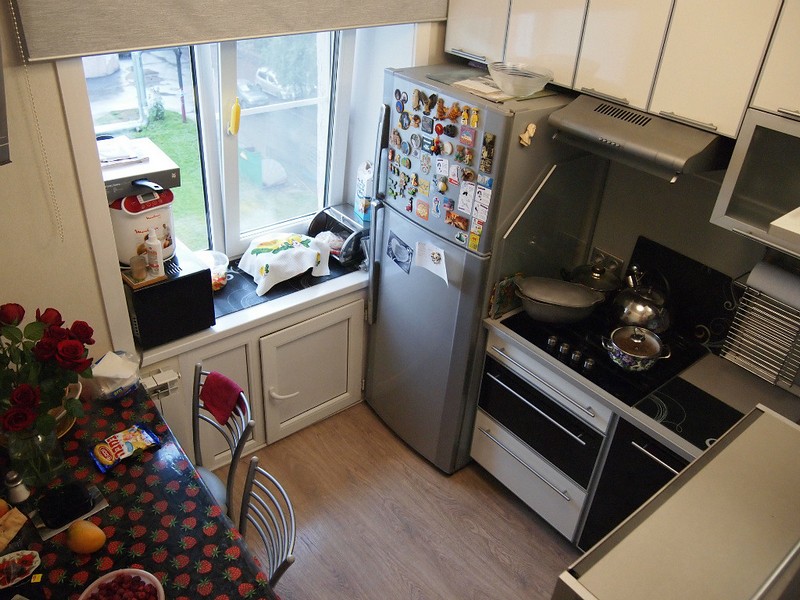
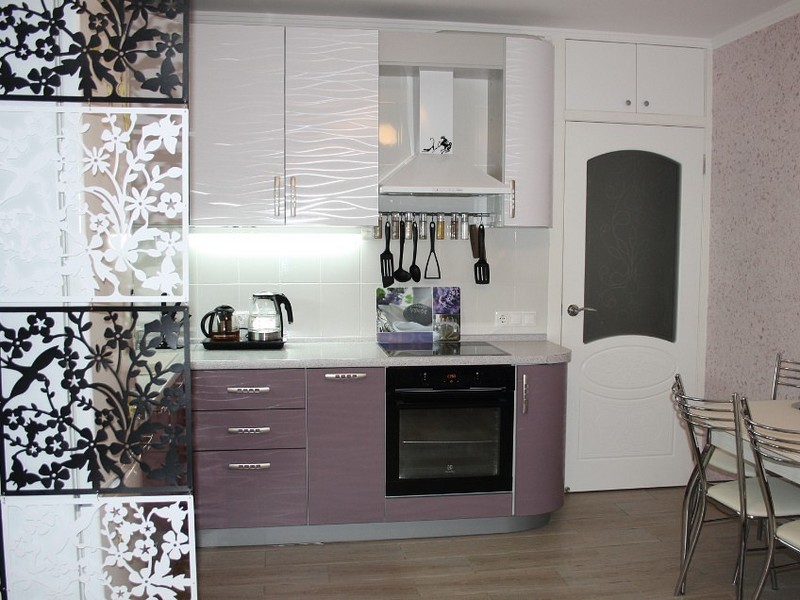
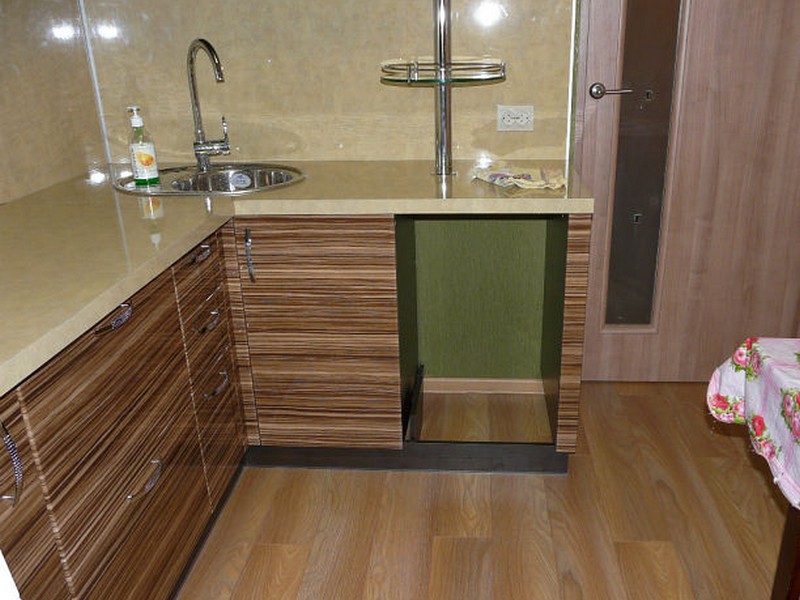
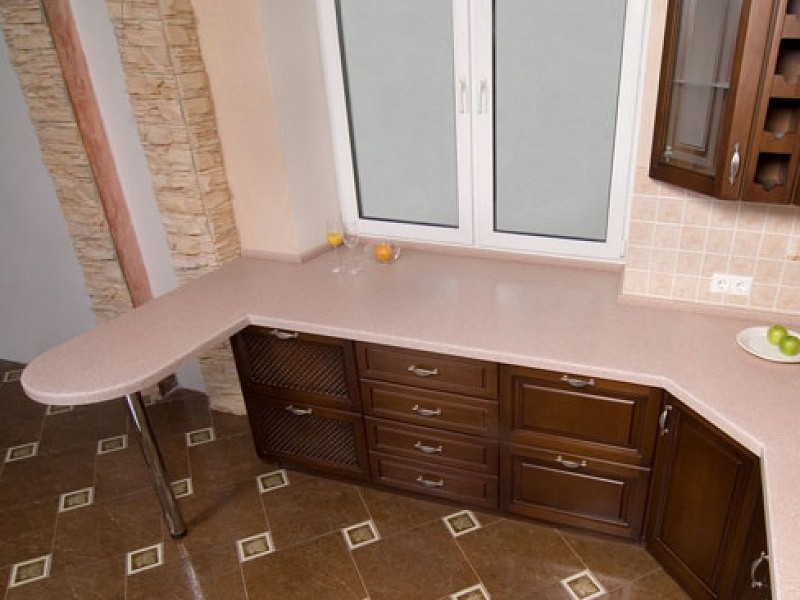
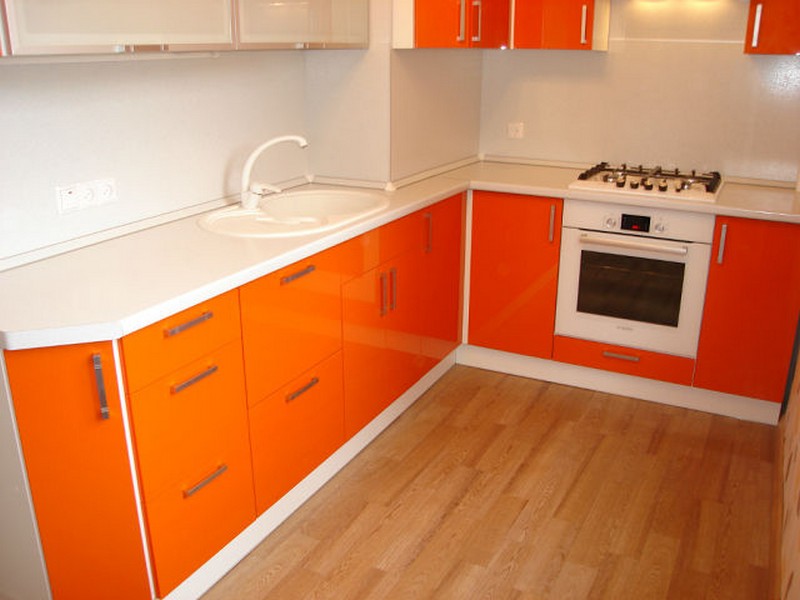
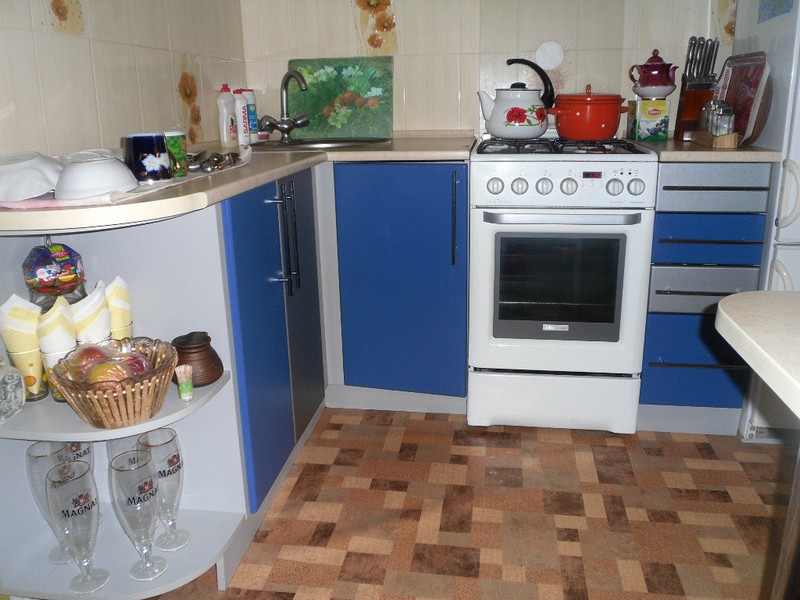
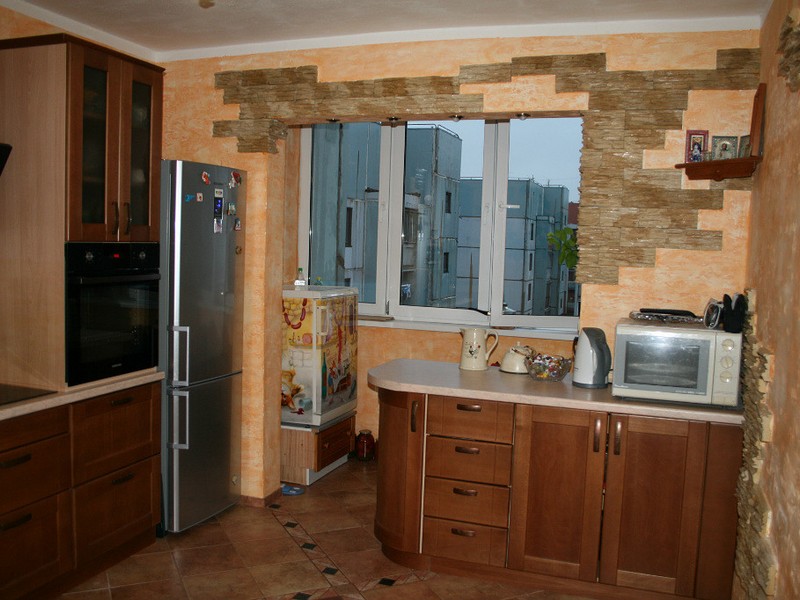
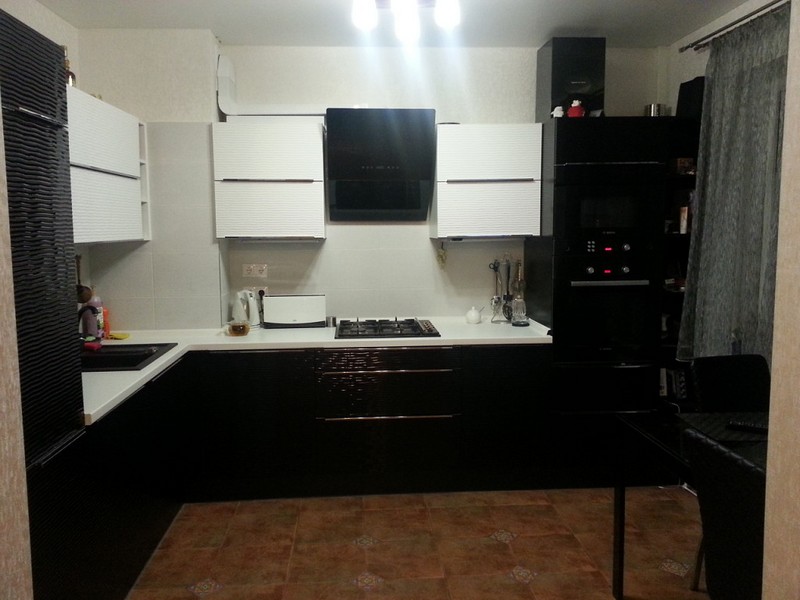
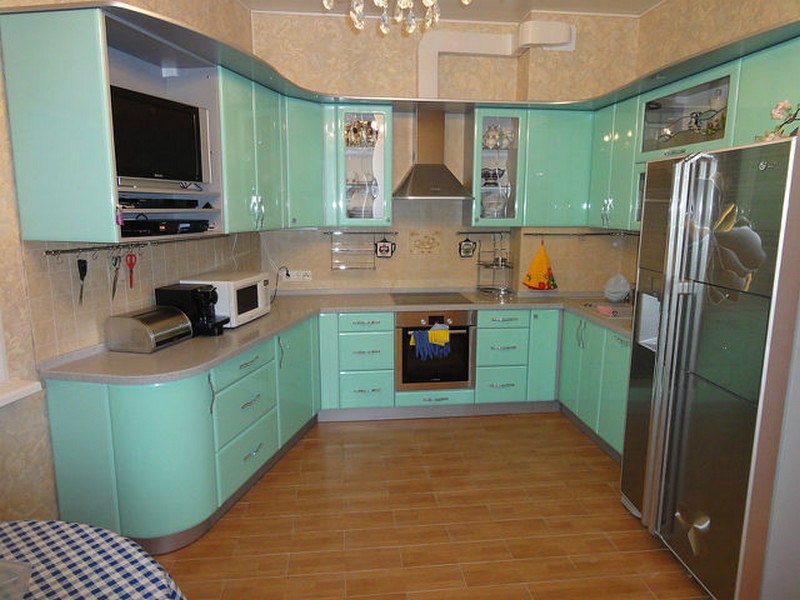

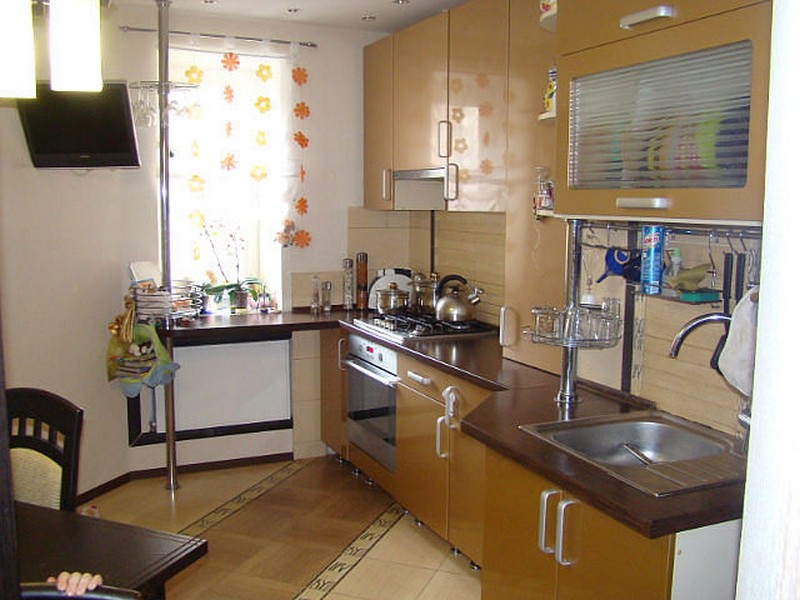
![]()
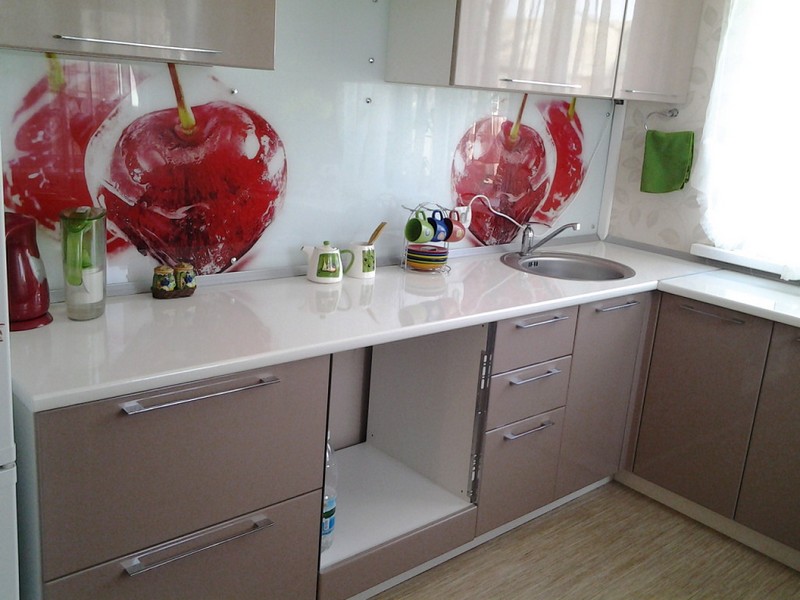
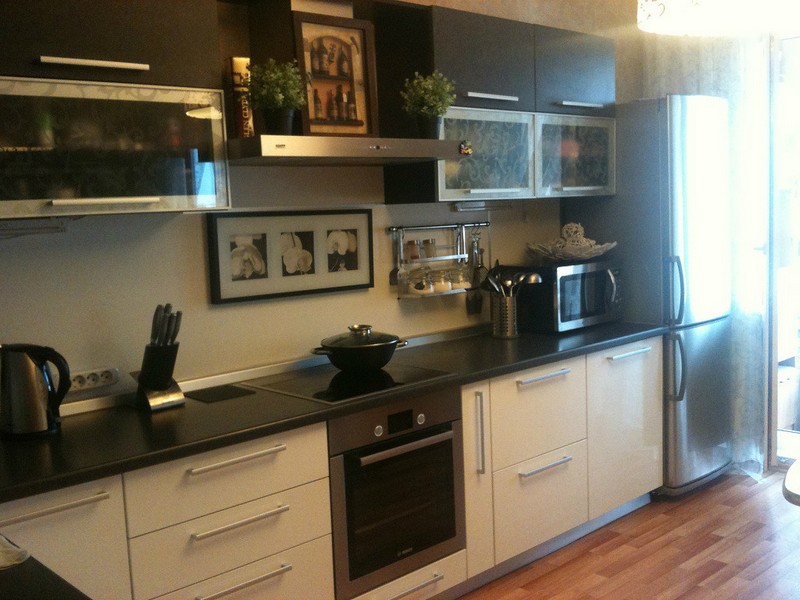
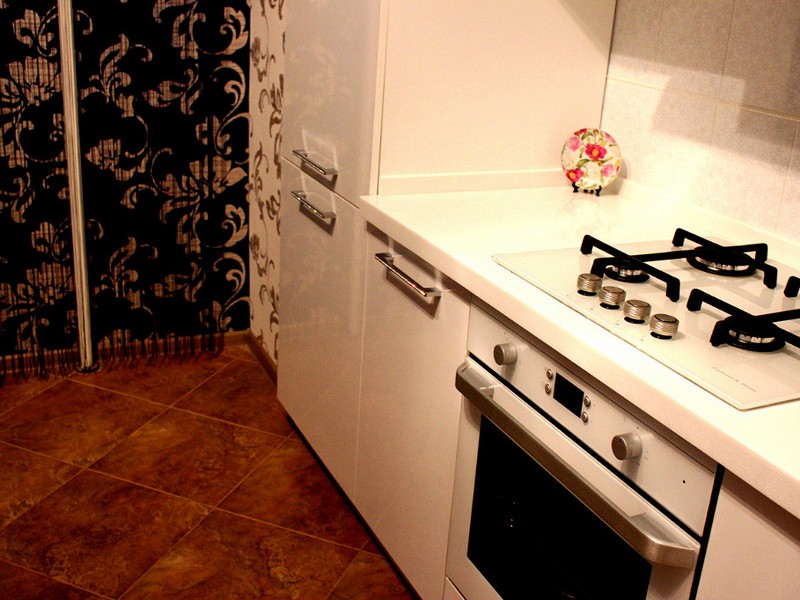
Linoleum was created more than 150 years ago as a cheaper alternative to wooden parquet. Previously, it was made from natural materials: flax, resin, wood chips, limestone, jute. Today it is also made from synthetics - polyvinyl chloride or PVC. Linoleum colors vary widely from classic to modern.
Durable flooring can be laid throughout the entire residential area and in commercial premises. Linoleum is easy to handle and hygienic. Fungi and bacteria do not multiply on its surface; a mop and a vacuum cleaner are enough for cleaning.
Fresh and bright colors of linoleum, imitating parquet, marble, granite, fantastic designs, are effectively combined with interior items of almost any style and direction.
Color Choice: Basics
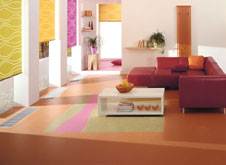
Color in a room is of particular importance, this applies to living rooms and offices. It can stimulate any mood - invigorate, refresh, give coolness, reassure. Modern linoleum is able to embody all the creative impulses of the designer, be it country or retro style.
Creating bright accents is made possible thanks to the huge number of shades that can be combined with each other. Various children's drawings and intricate prints offer virtually unlimited design possibilities.
But linoleum is not only beautiful, but also very practical. The smooth surface and natural resistance to bacteria make it a unique environmental flooring.
The time has passed when the only flooring options were planks or parquet. Today, decorating a space is easy - colored linoleum will bring a natural motif into everyday life. The most daring combinations will replace boring gray or brown shades.
Color selection rules
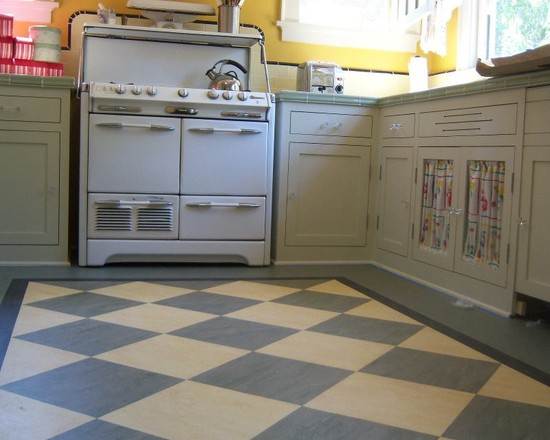
What color of linoleum should you choose to create a comfortable space? You can purchase any shade you like - even the most durable and high-quality coating will not last more than 5 years without losing its original appearance. And it can be easily replaced with a new one.
There are certain rules that should be followed when making a purchase and planning the interior.
Flooring instructions:
- For a room located on the sunny side, cool shades of blue and blue are suitable. They will add coolness to the room. Green and gray will fit well.
- For a small room it is advisable to use light pastel colors. They visually expand the boundaries, making the room larger - apricot, peach, pistachio, soft pink.
- Bright rich colors, unusual combinations are an excellent option for large living rooms, bedrooms and children's rooms, especially those located on the shady side of the house. It will bring warmth and light, which is exactly what is missing here.
- The brighter the flooring, the calmer the color of the walls should be.– otherwise it will be difficult to stay in such an interior for a long time. White, sand, beige, and the color of baked milk will serve as the best option for a rich floor.
- The color of linoleum in the interior of a nursery should be soothing, but at the same time invigorating, promoting fun games during the day and sound sleep in the evening. Delicate green, blue, muted shades are a good option.
- For the bedroom, you can choose an original textured flooring with a pattern that imitates tiles or parquet. Warm or cool tones. An excellent option would be linoleum with oriental ornaments or a pattern inspired by ancient frescoes. It will set the tone for the entire space.
The color scheme subconsciously influences the perception of the interior. Before giving preference to one or another option, it would be good to decide on the purpose of the room.

Important!
Each person experiences color differently.
This is exactly what you should start from when choosing the tone of the flooring.
And only then think through the rest of the interior so that it is in harmony with the floor.
The color of linoleum and its effect on psychological perception:
- Soft pastel colors are conducive to a calm, quiet conversation. If the goal is to create a cozy living room, then beige and brown shades without sharp transitions and contrasts are the best option. Light, refreshing natural tones make the interior unobtrusive and a little cool.
- Bright, catchy linoleum will add energy to the space and enliven it. It is acceptable in any room of the house, perhaps only the bedroom. By combining an eccentric floor with simple walls you can achieve an interesting visual effect.
- A floor covering of a muted monochromatic shade can cool down the overly bright walls a little - there is no need to overload the interior.
- On, imitating natural stone, marble or granite. They give a feeling of purity and push boundaries. If you want warmth and comfort, then the color of wood is exactly what you need.
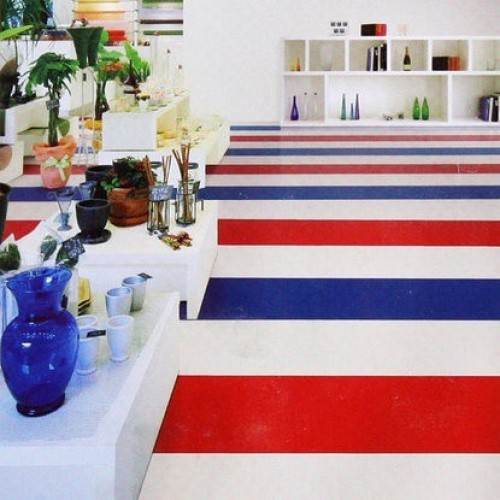
Multi-colored linoleum deserves special attention. A riot of colors is appropriate in bright, extravagant interiors. Where several completely different elements from different styles and eras perfectly coexist. This is a clear example that flooring can also be part of the original design.
Typical mistakes when choosing flooring colors
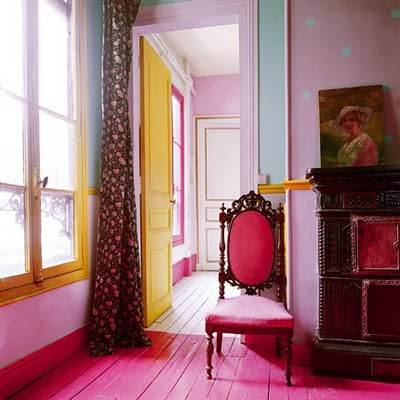
Correct selection of linoleum by color is an important step in creating a harmonious interior. There are a number of typical mistakes, making which can easily spoil the overall impression of the space.
Errors:
- Overloading the interior with any one color or its shades - the floor should be in harmony, for example, with sofa cushions, tabletops, lampshades.
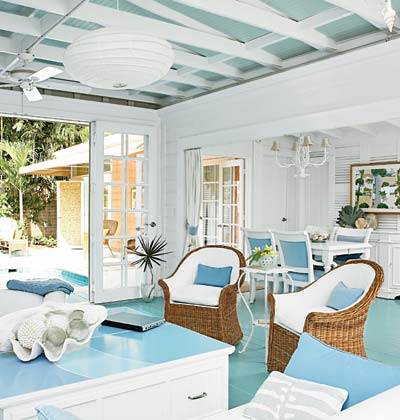
- You cannot make furniture and linoleum of the same color or similar shades. This tires the eyes and creates the feeling that the floor and furniture are one whole. You can make bright accents, but very carefully.
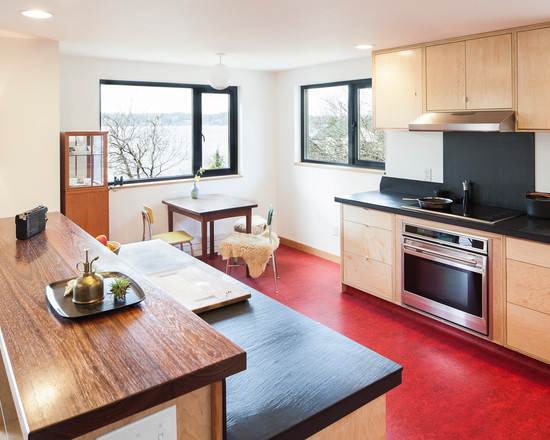
- Rich red and burgundy colors should be handled with care. These are some of the most aggressive shades. Only in the hands of an experienced designer can they play correctly. With their help you can create an intimate, expensive interior.
Note!
If you have an irresistible desire to decorate the floor with red or burgundy linoleum, then you should definitely add white to the interior.
It will soften aggression and add elegance and lightness.
Unusual shades of linoleum in the interior
It's quite easy to do with your own hands. This is available without special skills. You just need to first select and buy the material of the desired color.
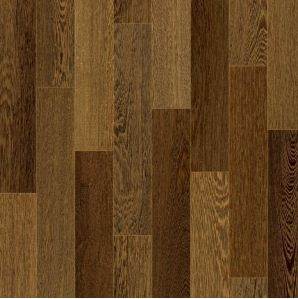
laying linoleum
Quite simple. This is available without special skills. You just need to first select and buy the material of the desired color.
The more unusual the tone and pattern, the more carefully you need to approach the purchase. Having previously thought out the interior to the smallest detail. This particularly applies to a new product on the flooring market – 3D linoleum.
Lovers of naturalness will appreciate wenge-colored linoleum. The pleasant dark shade does not irritate the eyes and is appropriate in any room.
It's quite easy to do with your hands. This is available without special skills. You just need to first select and buy the material of the desired color.
The more unusual the tone and pattern, the more carefully you need to approach the purchase. Having previously thought out the interior to the smallest detail. This particularly applies to a new product on the flooring market – 3D linoleum.
Lovers of naturalness will appreciate wenge-colored linoleum. The pleasant dark shade does not irritate the eyes and is appropriate in any room.

This new product will not leave either the apartment resident or the owner of a country house indifferent. It visually enlarges the space, creates depth, immersing you in a new world. Even simple green linoleum, but with a 3D ornament, will change the design.
The flooring successfully imitates the surface of water, meadows full of roses and daisies, and much more, which allows you to get closer to nature. Textures are not limited to natural themes; you can find textured linoleum, which is difficult to distinguish from marble or rare wood.
The price of this unusual material is slightly higher than that of conventional flooring.
But the benefits outweigh:
- Increased strength;
- Abrasion resistance;
- The ability to withstand mechanical stress - you can move heavy furniture without fear of damaging the coating;
- Retains its original appearance much longer - it does not fade or deteriorate due to temperature changes.
3D linoleum is sold in rolls up to 4 meters wide, allowing you to cover large rooms.
Conclusion
It is easy to care for and does not cause allergies. Creating the interior of your dreams will now not be difficult. And the video in this article will confirm everything said above with clarity, take a look!" width="640" height="480" frameborder="0" allowfullscreen="allowfullscreen">
Conclusion
Linoleum is a beautiful material, reliable and durable. It is equally appropriate in the living room, bedroom, nursery and even bathroom. The variety of colors and designs makes it a versatile flooring.
It is easy to care for and does not cause allergies. Creating the interior of your dreams will now not be difficult. And the video in this article will confirm everything said above with clarity, watch it!
can be safely considered a good alternative to wood or ceramic coating. The pricing policy is more than loyal. So a natural base made of resins, flax, shavings will cost more than a synthetic PVC coating. This coating is easy to handle and easy to install. Due to modern processing, color, texture and relief can be very diverse.
Linoleum colors in the interior
When choosing the color of linoleum, for example, for the kitchen, it is not enough to rely on your own taste. It is worth considering the practicality and reliability of a potential purchase. In a room located on the sunny side, blue and light blue tones will fit perfectly. Gray linoleum, as well as green linoleum, is the right approach.
Small dimensions can be expanded with a light pastel floor. It can be linoleum, apricot, peach, pistachio. For finishing a large area, linoleum in wenge color is suitable; use dark shades.
Black linoleum is not used so often, despite its practicality. Bright products are becoming increasingly popular. Feel free to make such a floor in a nursery or in a room on the shady side of the house.
Linoleum - errors in color and pattern
Using contrast is a good technique in the interior, however, the brighter the walls, the calmer the color of the floor and vice versa. You can stay with the neutral option. White and beige linoleum colors will “unload” the space.
Which linoleum and color is better? Linoleum, for example, in a living room can be color-matched not only to walls or furniture, but also to accessories: table top, lampshades, pillows or curtains. If you need to cover the floor of 2 adjacent rooms, you should not choose models that are fundamentally different in color, it will be noticeable. Linoleum should be chosen to match the color of the laminate. Be careful with aggressive colors (red, light green, yellow); it is advisable to dilute them with white or muted brown interior elements.
